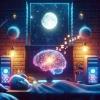
In today's fast-paced digital world, sleep often takes a backseat. Yet, it is as crucial to our well-being as food and water. Technology, while a marvel in many respects, can be a mischievous thief when it comes to our slumber. This article delves into the intricate dance between technology and our sleep cycles, exploring the science behind it and offering practical strategies to reclaim our rest.
Understanding the Sleep Cycle
To truly grasp how technology affects our sleep, we must first understand the sleep cycle itself. Sleep is a complex process involving several stages, each playing a unique role in our health. These stages are generally categorized into REM (Rapid Eye Movement) and non-REM sleep. Non-REM sleep is further divided into light sleep and deep sleep phases. REM sleep is when most dreaming occurs and is vital for cognitive functions like memory and learning.
The sleep cycle repeats several times during a typical night, with each cycle lasting about 90 minutes. Disruptions in this cycle can lead to sleep disorders, affecting both physical and mental health. It's essential to maintain a balanced cycle to feel rested and rejuvenated.
How Technology Disrupts Sleep
With the advent of smartphones, tablets, and laptops, technology has become an integral part of our lives. However, it also poses significant challenges to our sleep. One of the primary culprits is blue light emission from screens, which can interfere with the production of melatonin, the hormone responsible for regulating sleep-wake cycles.
Moreover, the constant notifications and the allure of social media can keep our brains engaged long past bedtime. The stimulation from these activities can delay the onset of sleep and reduce overall sleep quality. Additionally, using devices in bed can condition our minds to associate the bedroom with wakefulness rather than rest.
The Science of Blue Light
Blue light, a short-wavelength light, is known to boost alertness and mood during the day. However, exposure to it at night can be detrimental. It inhibits melatonin production, tricking the brain into thinking it's still daytime. This disruption can lead to delayed sleep phase syndrome, a condition where one struggles to fall asleep at a conventional time.
Research has shown that even a small amount of screen time before bed can significantly impact sleep quality. This effect is more pronounced in teenagers, whose sleep cycles are already more sensitive to light changes. Limiting exposure to screens at least an hour before bedtime can help mitigate these effects.
Practical Strategies to Improve Sleep
So, what can we do to ensure technology doesn't rob us of our precious sleep? Here are some practical strategies:
1) **Create a Tech-Free Zone in the Bedroom**: Designate your bedroom as a sanctuary for sleep. Keep electronic devices out to create a restful environment.
2) **Set a Digital Curfew**: Establish a cut-off time for screen use, ideally one to two hours before bedtime. This gives your brain time to wind down and prepare for sleep.
3) **Use Blue Light Filters**: Many devices now offer night mode settings that reduce blue light emission. Using these features can be beneficial if you must use screens in the evening.
4) **Practice Mindfulness and Relaxation Techniques**: Activities like meditation, deep breathing, or reading a physical book can help signal to your body that it's time to sleep.
5) **Keep a Consistent Sleep Schedule**: Going to bed and waking up at the same time every day helps regulate your body's internal clock, making it easier to fall asleep and wake up naturally.
Common Mistakes to Avoid
As you embark on your journey to better sleep, here are some common pitfalls to sidestep:
1) **Using Devices as Alarm Clocks**: While convenient, keeping your phone by the bed can tempt you to check it late at night. Opt for a traditional alarm clock instead.
2) **Caffeine and Screen Time**: Consuming caffeine too late in the day and using screens before bed can create a double whammy for your sleep cycle.
3) **Inconsistent Sleep Environment**: Ensure your bedroom is dark, cool, and quiet. Inconsistent environments can disrupt sleep and delay the onset of restful slumber.
4) **Ignoring Exercise**: Regular physical activity can promote better sleep, but try to avoid vigorous exercise close to bedtime, as it can be too stimulating.
Conclusion: Balancing Tech and Sleep
In a world where technology is ubiquitous, finding balance is key. By understanding the science of sleep and how technology impacts it, we can make informed choices that prioritize our well-being. Implementing small changes in our daily routines can lead to significant improvements in sleep quality, ultimately enhancing our overall health and productivity. Remember, a good night's sleep is not a luxury—it's a necessity.































